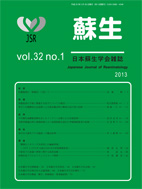Volume 32, Issue 1
Japanese Journal of Reanimatology vol.32 no.1
Displaying 1-9 of 9 articles from this issue
- |<
- <
- 1
- >
- >|
-
2013 Volume 32 Issue 1 Pages 1-6
Published: March 28, 2013
Released on J-STAGE: May 02, 2013
Download PDF (2475K)
-
2013 Volume 32 Issue 1 Pages 7-10
Published: March 28, 2013
Released on J-STAGE: May 02, 2013
Download PDF (1111K) -
2013 Volume 32 Issue 1 Pages 11-15
Published: March 28, 2013
Released on J-STAGE: May 02, 2013
Download PDF (1913K)
-
2013 Volume 32 Issue 1 Pages 16-19
Published: March 28, 2013
Released on J-STAGE: May 02, 2013
Download PDF (1082K) -
2013 Volume 32 Issue 1 Pages 20-22
Published: March 28, 2013
Released on J-STAGE: May 02, 2013
Download PDF (1066K)
-
2013 Volume 32 Issue 1 Pages 23-28
Published: March 28, 2013
Released on J-STAGE: May 02, 2013
Download PDF (2094K)
-
2013 Volume 32 Issue 1 Pages 29-35
Published: March 28, 2013
Released on J-STAGE: May 02, 2013
Download PDF (2575K) -
2013 Volume 32 Issue 1 Pages 36-41
Published: March 28, 2013
Released on J-STAGE: May 02, 2013
Download PDF (2264K) -
2013 Volume 32 Issue 1 Pages 42-44
Published: March 28, 2013
Released on J-STAGE: May 02, 2013
Download PDF (817K)
- |<
- <
- 1
- >
- >|
